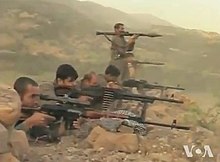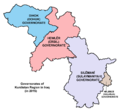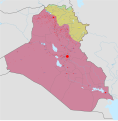
Back بوابة:كردستان Arabic Портал:Кюрдистан Bulgarian دەروازە:کوردستان CKB Portal:Kurdistan German درگاه:کردستان Persian Portail:Kurdistan French Portal:Kurdistan Kurdish Portaal:Koerdistan Dutch Portal:Curdistão Portuguese باب:خيبر پختونخوا Sindhi
The Kurdistan Portal Kurdistan (Kurdish: کوردستان, romanized: Kurdistan, lit. 'land of the Kurds'; [ˌkʊɾdɪˈstɑːn] ⓘ), or Greater Kurdistan, is a roughly defined geo-cultural region in West Asia wherein the Kurds form a prominent majority population and the Kurdish culture, languages, and national identity have historically been based. Geographically, Kurdistan roughly encompasses the northwestern Zagros and the eastern Taurus mountain ranges. Kurdistan generally comprises the following four regions: southeastern Turkey (Northern Kurdistan), northern Iraq (Southern Kurdistan), northwestern Iran (Eastern Kurdistan), and northern Syria (Western Kurdistan). Some definitions also include parts of southern Transcaucasia. Certain Kurdish nationalist organizations seek to create an independent nation state consisting of some or all of these areas with a Kurdish majority, while others campaign for greater autonomy within the existing national boundaries. The delineation of the region remains disputed and varied, with some maps greatly exaggerating its boundaries. Historically, the word "Kurdistan" is first attested in 11th century Seljuk chronicles. Many disparate Kurdish dynasties, emirates, principalities, and chiefdoms were established from the 8th to 19th centuries. Administratively, the 20th century saw the establishment of the short-lived areas of the Kurdish state (1918–1919), Kingdom of Kurdistan (1921–1924), Kurdistansky Uyezd i.e. "Red Kurdistan" (1923–1929), Republic of Ararat (1927–1930), and Republic of Mahabad (1946). In Iraq, following the Aylūl Revolt, the government entered into an agreement with the rebellious Kurds, granting Kurds local self-rule. Soon after, however, the agreement collapsed. Later, during the Iraqi no-fly zones conflict, which followed the Gulf War, the Iraqi military withdrew from parts of northern Iraq, allowing the Kurds to fill the vacuum and regain lost control in those areas. After the invasion of Iraq, and since the creation of the new Iraqi federal state, the new constitution issued in 2005 recognises Kurdistan Region as a federal region; even though the constitution does not include the term “autonomy”, it emphasises decentralisation and devolution, allowing regions and governorates to administer local affairs. In practice, however, only Kurdistan Region has exercised this authority granted by the constitution. In September 2017, Iraqi Kurds held a one-sided independence referendum, which eventually failed and was abandoned. The subsequent effort by the Iraqi government to punish Kurdistan Region has resulted in the latter losing authorities it had previously possessed, and the future of Kurdish autonomy in Iraq has been called into question. Iraqi Kurdish officials have also complained of efforts by the Iraqi government to return to the pre-2003 centralized government and dismantle Kurdistan Region altogether. There is also a Kurdistan Province in Iran, which is not self-ruled. Kurds fighting in the Syrian civil war were able to take control of large sections of northern Syria and establish self-governing regions in an Autonomous Administration of North and East Syria (commonly called Rojava), where they seek autonomy in a federal Syria after the war. (Full article...) Selected article -Kurdish separatism in Iran or the Kurdish–Iranian conflict is an ongoing, long-running, separatist dispute between the Kurdish opposition in Western Iran and the governments of Iran, lasting since the emergence of Reza Shah Pahlavi in 1918. The earliest Kurdish separatist activities in modern times refer to tribal revolts in today's West Azerbaijan Province of the Imperial State of Iran, which began between the two World Wars – the largest of these were led by Simko Shikak, Jafar Sultan and Hama Rashid. Many however, put the starting point of the organized Kurdish political-nationalist separatism at 1943, when Komala (shortly afterwards the Kurdish Democratic Party of Iran (KDPI) began their political activities in Iran, aiming to gain partial or complete self-rule in the Kurdish regions. Transformation from tribal to Kurdish political struggle in Iran took place in the aftermath of World War II, with the KDPI establishing the Republic of Mahabad during the 1946 Iran crisis. The USSR-supported attempt to establish a Kurdish state in Western Iran failed. More than a decade later, peripheral tribal uprisings, launched with KDPI support through 1966–7. In the most violent episode of the conflict, more than 30,000 Kurds died in the 1979 rebellion and the consequent KDPI insurgency. Though the KDPI's armed struggle ended in late 1996, another Kurdish armed organization emerged in Iran by the early 2000s. The ongoing Iran-PJAK conflict started in 2004. (Full article...) General images -The following are images from various Kurdistan-related articles on Wikipedia.
Related portals'Religions in Kurdistan Arab states Other countries Selected picture Erbil citadel, a World Heritage Site
Did you know
CategoriesTopicsNew articlesThis list was generated from these rules. Questions and feedback are always welcome! The search is being run daily with the most recent ~14 days of results. Note: Some articles may not be relevant to this project.
Rules | Match log | Results page (for watching) | Last updated: 2025-01-26 21:25 (UTC) Note: The list display can now be customized by each user. See List display personalization for details.
Things you can do
Associated WikimediaThe following Wikimedia Foundation sister projects provide more on this subject:
Sources
Discover Wikipedia using portals |











































